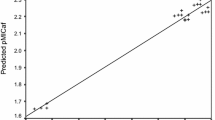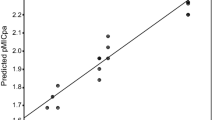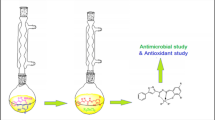Abstract
A series of organotin(IV) complexes of type R2SnLCl [R = Ph, Bu, Et, Me] were prepared by reaction of diorganotindichloride(IV) with Schiff base ligands, L1 = (1-[(6-ethoxy-benzothiazol-2-ylimino)-methyl]-naphthalen-2-ol), L2 = (1-[(6-nitro-benzothiazol-2-ylimino)-methyl]-naphthalen-2-ol), L3 = (1-[(6-methoxy-benzothiazol-2-ylimino)-methyl]-naphthalen-2-ol) and L4 = (1-[(6-methyl-benzothiazol-2-ylimino)-methyl]-naphthalen-2-ol) obtained from 2-amino-6-substituted benzothiazole derivatives with 2-hydroxy-1-naphthaldehyde in 1:1 molar ratio. These organotin(IV) complexes were characterized by various spectroscopic techniques (1H, 13C and 119Sn NMR, FT-IR), and physical techniques (X-ray powder diffraction analysis and elemental analysis). The coordination of the prepared complexes has been planned as pentacoordinated around the central tin atom during which ligands coordinated to tin atom in bidentate manner acted as N, O donor system. The ligands and their complexes were screened for antibacterial and antifungal activities against Gram-positive bacteria Bacillus cereus (MTCC 10072), Staphylococcus aureus (NCIM 2901), Gram-negative bacteria Escherichia coli (MTCC 732), Pseudomonas aeruginosa (MTCC 424) and fungi Aspergillus niger (MTCC 9933) and Aspergillus flavus (ATCC 76801). The output of QSAR analysis indicated that topological parameters (molecular connectivity indices) were responsible for controlling the antimicrobial activity of the synthesized compounds.

Similar content being viewed by others
References
Aman R, Matela G (2013) Tin (IV) complexes of Schiff base derived from amino acid: synthesis and characteristic spectral studies. J Chem 2013:1–4. doi:10.1155/2013/637290
Asija S, Malhotra N, Malhotra R (2012) Bioactive penta-coordinated diorganotin(IV) complexes of Pyridoxalimine Schiff bases. Phosphorus Sulfur Silicon 187:1510–1520. doi:10.1080/10426507.2012.692129
Balaban AT (1982) Highly discriminating distance based topological indices. Chem Phys Lett 89:399–404. doi:10.1016/0009-2614(82)80009-2
Basu S, Masharing C, Das B (2012) Diorganotin(IV) complexes of polyaromatic azo-azomethine ligand from salicylaldehyde and ortho-aminophenol: synthesis, characterization and molecular structure. Heteroatom Chem 23(5):457–465. doi:10.1002/hc.21037
Baul TSB, Masharing C, Basu S, Pettinari C, Rivarola E, Chantrapromma S, Fun HK (2008) Synthesis, characterization of some diorganotin(IV) complexes of Schiff bases derived from a non-protein amino acid. Crystal structures of HO2CC6H4[N=C(H)}{C(CH3)CH(CH3)–3–OH]-p and its di-n-butyltin(IV) complex (nBu2Sn{O2CC6H4[N=C(H)}{C(CH3)CH(CH3)–3–OH]–p}2). Appl Organometal Chem 22:114–121. doi:10.1002/aoc.1358
Beltran HI, Zea CD, Ortega SH, Camacho AN, Apan MTR (2007) Synthesis and characterization of di-phenyl-tin(IV)-salicyliden-ortho-aminophenols: analysis of in vitro antitumor/antioxidant activities and molecular structures. Inorg Biochem 101:1070–1085. doi:10.1016/j.**orgbio.2007.04.002
Braunstein P, Morise X (2000) Dehydrogenative coupling of hydrostannanes catalyzed by transition-metal complexes. Chem Rev 100:3541–3552. doi:10.1021/cr000444d
Devi J, Kumari S, Malhotra R (2012) Synthesis, spectroscopic studies, and biological activity of organosilicon(IV) complexes of ligands derived from 2-aminobenzothiazole derivatives and 2-hydroxy-3-methoxy benzaldehyde. Phosphorus Sulfur Silicon 187:587–597. doi:10.1080/10426507.2011.634465
Dias LC, Lima GM, Takahashi JA, Ardisson JD (2015) New di- and triorganotin(IV) carboxylates derived from a Schiff base: synthesis, characterization and in vitro antimicrobial activities. Appl Organometal Chem 29:305–313. doi:10.1002/aoc.3292
Ekennia AC, Onwudiwe DC, Olasunkanmi LO, Osowole AA, Ebenso EE (2015) Synthesis, DFT calculation, and antimicrobial studies of novel Zn(II), Co(II), Cu(II), and Mn(II) heteroleptic complexes containing benzoylacetone and dithiocarbamate. Bioinorg Chem Appl 2015:1–12. doi:10.1155/2015/789063
Elebier MC, Ahin ES, Ancın N, Oztaş NA, Oztas SG (2007) Synthesis and characterization of diorganotin (IV) complexes of Schiff bases with ONO-type donors and crystal structure of [N-(2-hydroxy-4-nitrophenyl)-3-ethoxysalicylideneiminato] diphenyltin (IV). Appl Organometal Chem 21:913–918. doi:10.1002/aoc.1311
Gill RK, Rawal KR, Bariwal J (2015) Recent advances in the chemistry and biology of benzothiazoles. Arch Pharm Chem Life Sci 348:155–178. doi:10.1002/ardp.201400340
Golbraikh A, Tropsha A (2002) Beware of q2. J Mol Gr Model 20:269–276. doi:10.1016/s1093-3263(01)00123-1
Gonzalez A, Gomez E, Lozada AC, Hernandez S, Apan TR, Comacho AN (2009) Heptacoordinate tin(IV) compounds derived from pyridine Schiff bases: synthesis, characterization, in vitro cytotoxicity, anti-inflammatory and antioxidant activity. Chem Pharm Bull 57(1), 5–15. doi:19122310
Hansch C, Fujita ST (1964) ρ-σ-π analysis. A method for the correlation of biological activity and chemical structure. J Am Chem Soc 86:1616–1626. doi:10.1021/ja010629035
Hansch C, Leo A, Unger SH, Kim KH, Nikaitani D, Lien EJ (1973) Aromatic substituent constants for structure-activity correlations. J Med Chem 16(11):1207–1216. doi:10.1021/jm00269a003
Hong M, Yin HD, Chen SW, Wang DQ (2010) Synthesis and structural characterization of organotin(IV) compounds derived from the self-assembly of hydrazone Schiff base series and various alkyltin salts. J Organomet Chem 695:653–662. doi:10.1016/j.jorganchem.2009.11.035
Hyperchem 6.0, Hypercube Inc (1993) Florida
Judge V, Narasimhan B, Ahuja M, Sriram D, Yogeeswari P, De Clercq E, Pannecouque C, Balzarini J (2012a) Isonicotinic acid hydrazide derivatives: synthesis, antimicrobial activity and QSAR studies. Med Chem Res 21(7):1451–1470. doi:10.1007/s00044-011-9662-9
Judge V, Narasimhan B, Ahuja M, Sriram D, Yogeeswari P, De Clercq E, Pannecouque C, Balzarini J (2012b) Synthesis, antimycobacterial, antiviral, antimicrobial activity and QSAR studies of isonicotinic acid-1-(substituted phenyl)-ethylidene/cycloheptylidene hydrazides. Med Chem Res 21(8):1935–1952. doi:10.1007/s00044-011-9705-2
Kashar TI (2014) Synthesis, characterization and biological activity of some metal complexes of benzoylacetone Schiff base. Eur Chem Bull 3(9), 878–882. doi:02200/02286/00031
Kemmer M, Dalil H, Biesmans M (2000) Dibutyltin perfluoroalkanecarboxylates: synthesis, NMR characterization and in vitro antitumour activity. J Organomet Chem 608:63–70. doi:10.1016/S0022-328X(00)00367-3
Kier LB, Hall LH (1976) Molecular connectivity in chemistry and drug research. Academic Press, NewYork. doi:10.1002/jps.2600660852
Kumar A, Narasimhan B, Kumar D (2007) Synthesis, antimicrobial and QSAR studies of substituted benzamides. Bioorg Med Chem 15:4113–4124. doi:10.1016/j.bmc.2007.03.074
Lather V, Madan AK (2005) Topological models for the prediction of anti-HIV activity of dihydro(alkylthio) (naphthylmethyl) oxopyrimidines. Bioorg Med Chem 13, 1599–1604. http://www.ncbi.nlm.nih.gov/labs/article/15698777/
Mene D, Kale M (2016) Exploration of different methodologies for synthesizing biologically important benzothiazoles: an overview. Curr Org Synth 13(1):41–57. doi:10.2174/1570179412999150723154128
Mohammadi K, Zahedi M (2012) Tridentateschiff base compounds of 2-aminophenol: synthesis, characterization and complexation with IIIA elements. Global J Inorg Chem 3(2), 1-12. doi:103637225
Mun LS, Hapipah MA, Shin SK, Nurestrib AMS, Mun LK (2012) “Synthesis, structural characterization and in vitro cytotoxicity of diorganotin complexes with Schiff base ligands derived from 3-hydroxy-2-naphthoylhydrazide. Appl Organometal Chem 26:310–319. doi:10.1002/aoc.2862
Nath M, Yadav R, Gielen M, Dalil H, Vos D, Eng G (1997) Synthesis, characteristic spectral studies and in vitro antimicrobial and antitumour activities of organotin(IV) complexes of Schiff bases derived from amino-acids. Appl Organometal Chem 11:727–736. doi:10.1002/(SICI)1099-0739(199709)11:9<727:AID-AOC639>3.0.CO;2-X
Nath M, Saini PK, Kumar A (2009) Synthesis, structural characterization, biological activity and thermal study of tri and diorganotin (IV) complexes of Schiff base derived from 2-aminomethylbenzimidazole. Appl Organometal Chem 23:434–445. doi:10.1002/aoc.1537
Nidhi Sonika, Malhotra R (2011) Synthesis and characterization of diorganotin(IV) complexes with tridentate Schiff base ligand pyridoxal aroylhydrazones. Phosphorus Sulfur Silicon 186:1449–1459. doi:10.1080/10426507.2010.517583
Randic M (1975) Characterization of molecular branching. J Am Chem Soc 97:6609–6615. doi:10.1021/ja00856a001
Randic M (1993) Comparative regression analysis: regression based on a single descriptor. Croat Chem Acta 66, 289–312. url:hrcak.srce.hr/137063
Sallam SA, Orabi AS (2002) Copper, nickel and cobalt complexes of Schiff-bases derived from β-diketones. Transit Metal Chem 27:447–453. doi:10.1023/A:1015085023602
Sedaghat T, Shokohi-pour Z (2009) Synthesis and spectroscopic studies of new organotin(IV) complexes with tridentate N- and O-donor Schiff bases. J Coord Chem 62(3):3837–3844. doi:10.1080/00958970903180103
Sharma P, Rane N, Gurram VK (2004) Synthesis and QSAR studies of pyrimido[4,5-d]pyrimidine-2,5-dione derivatives as potential antimicrobial agents. Bioorg Med Chem Lett 14:4185. doi:10.1016/j.bmcl.2004.06.014
Sharma A, Jain A, Saxena S (2015) The structure–activity relationship of some hexacoordinated dimethyltin(IV) complexes of fluorinated β-diketone/β-diketones and sterically congested heterocyclic β-diketones. Appl Organometal Chem 29(8):499–508. doi:10.1002/aoc.3321
Sharma C, Bansal PK, Kushal Aakash D, Pathak Meenakshi (2017) Benzothiazole derivatives as potential anti-infective agents. Curr Top Med Chem 17(2):208–237. doi:10.2174/1568026616666160530152546
Silva CM, Silva DL, Modolo LV, Alves RB, Resende MA, Martins CVB, Fatima AD (2011) Schiff bases: a short review of their antimicrobial activities. J Adv Res 2:1–8. doi:10.1016/j.jare.2010.05.004
Singh K, Kumar Y, Pundir RK (2010) Synthesis and characterization of biologically active organosilicon (IV) complexes with Schiff bases derived from o-aminothiophenol. Synth React Inorg Metal-org Nano-Met Chem 40:836–842. doi:10.1080/15533174.2010.522646
Sonika Narula AK, Vermani OP, Sharma HK, Sarpal AS (1994) Synthesis of bimetallic [Sn(IV), Al(III)]-μ-oxoisopropoxyacetate and bimetallic [Sn(IV), Al(III)]-μ-oxoisopropoxide and their acetylacetone and benzoylacetone derivatives. J Organometal Chem 470(1–2):67–72. doi:10.1016/0022-328x(94)80149-5
Spooner DF, Sykes G (1972) Methods in microbiology. Academic Press, London
SPSS for Windows, version 10.05, SPSS Inc (1999) Bangalore, India
TSAR 3D Version 3.3 (2000) Oxford Molecular Limited
Wiener H (1947) Structural determination of paraffin boiling points. J Am Chem Soc 69:17–20. doi:10.1021/ja011939005
Yenisehirli G, Oztas NA, Sahin E, Celebier M, Ancın N, Oztas SG (2010) Synthesis, characterization, and in vitro antimicrobial activities of organotin (IV) complexes of Schiff bases with ONO-type donor atoms. Heteroatom Chem 21(6):373–385. doi:10.1002/hc.20628/pdf
Yin HD, Chen SW (2006) Synthesis and characterization of di- and tri-organotin(IV) complexes with Schiff base ligand pyruvic acid 3-hydroxy-2-naphthoyl hydrazone. Inorg Chim Acta 359:3330–3338. doi:10.1016/j.ica.2006.03.024
Yin HD, Ganghi MH, Wang DQ (2005) Synthesis, characterization and structural studies of diorganotin(IV) complexes with Schiff base ligand salicylaldehyde and isonicotinylhydrazone. J Organomet Chem 690:3714–3719. doi:10.1016/j.jorganchem.2005.04.049
Acknowledgements
The authors are grateful to the Dr. A.P.J. Abdul Kalam-Central Instrumentation Laboratory, Guru Jambheshwar University of Science & Technology, Hisar and Sophisticated Analytical Instrument Facility, Punjab University, Chandigarh for providing IR and NMR facilities. One of the authors, Ms. Aarti Ahlawat is thankful to UGC, New Delhi for providing financial assistance under the Scheme Rajiv Gandhi National Fellowship. The authors are thankful to Dr. Namita Singh, Department of Bio and Nanotechnology, Guru Jambheshwar University of Science and Technology, Hisar for providing bacterial and fungal strains for evaluation of antimicrobial activities.
Author information
Authors and Affiliations
Corresponding author
Electronic supplementary material
Below is the link to the electronic supplementary material.
Rights and permissions
About this article
Cite this article
Ahlawat, A., Singh, V. & Asija, S. Synthesis, characterization, antimicrobial evaluation and QSAR studies of organotin(IV) complexes of Schiff base ligands of 2-amino-6-substituted benzothiazole derivatives. Chem. Pap. 71, 2195–2208 (2017). https://doi.org/10.1007/s11696-017-0213-9
Received:
Accepted:
Published:
Issue Date:
DOI: https://doi.org/10.1007/s11696-017-0213-9




